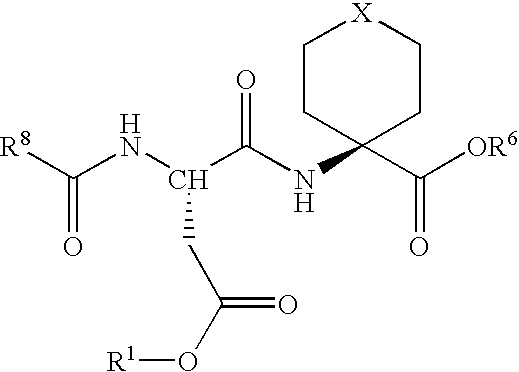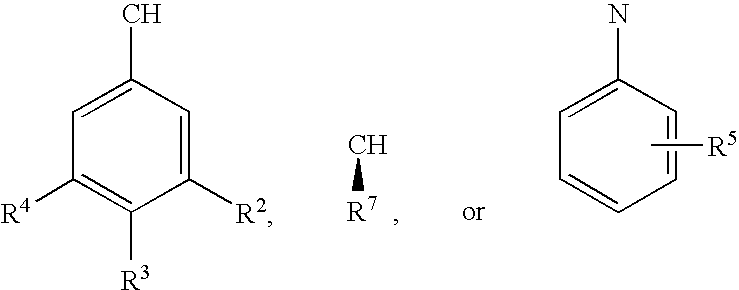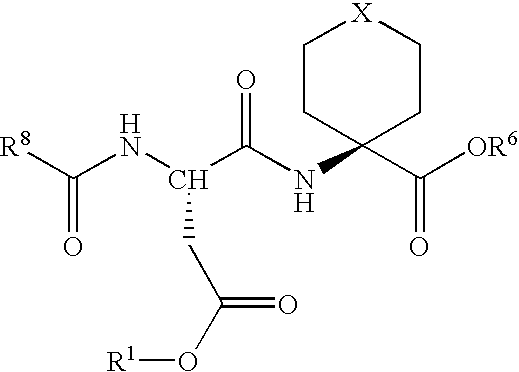Methods for the synthesis of cyclic peptides
a cyclic peptide and peptide technology, applied in the direction of peptides, peptide/protein ingredients, immunoglobulins, etc., can solve the problems of unfavorable product synthesized, undesirable by-products, and large quantities, and seriously impair yield or even ruin the product being synthesized from a practical perspectiv
- Summary
- Abstract
- Description
- Claims
- Application Information
AI Technical Summary
Benefits of technology
Problems solved by technology
Method used
Image
Examples
example i
Preparation of Fmoc-D-Phe-Arg(Pbf)-Trp(Boc)-Lys(Boc)-Resin
[0092]
Deprotection Knorr ResinCharged 6-L SPPS305.38gKnorr resin and3.6LDMF. Stirred at 100 RPM for 30 min then drained DMF.Refilled with3.0LDMF. The temperature was adjusted to 25° C.Drained reactor and deprotected with2 × 3.6L20% Piperidine / DMF for 60 min each. Washed resin with4 × 3.6LDMF
Couple Fmoc-Lys(Boc)-OH192.8gFmoc-L-Lysine(Boc)-OH63.44gHOBT hydrate68.0gDIEA1.7LDMF. The solution was cooled to 5° C. and combined with157.0gHBTU in1LDMF and cooled to 5° C. for 15 min.The activated ester solution was added to theSPPS and rinsed in with0.6LDCM. The coupling was maintained for 3 h.(Reactor vol = 4.7 L).Sampled for completion (Kaiser) at 2 and 3 h. Bothsamples were ninhydrin colorless.Drained reactor and washed with4 × 3.6LDMF. Drained reactor and deprotected with2 × 3.6L20% Piperidine / DMF for 30 min each. Washed resin with4 × 3.6LDMF.
Couple Fmoc-Trp(Boc)-OH125.32gFmoc-L-Trp(Boc)-OH63.44gHOBT hydrate68.0gDIEA1.7LDMF. The so...
example 2
Preparation of Pentanoyl-Asp-(OtBu)-4-MeO-Apc-OH
[0093]
Loading Fmoc-4-MeO-Apc-OHCharged 6-L SPPS300.07g2-CTC-Resin and3LDCM. Stirred 30 min. Made up a solution of84.87gFmoc-4-MeO-Apc-OH in2.1LDMF and0.3LDCM. The solution was stirred for 30 min and69.83gDIEA added. The solution was then charged to the swollen resin. Stirringwas continued for 20 h. The resin was drained and stirred with3LDMF for 5 min. End capping was achieved by addition of a solution of0.3LDIEA in0.27LMethanol and stirring for 1 h. The resin was drained and washed with3LDMF followed by an additional1.5LDMF. The resin was then washed with5 × 3LDCM (The 5th wash was UV negative). The resin was then washed with3 × 3LDMF. The resin was drained and deprotected with2 × 2.3L20% Piperidine / DMF for 30 min each. Washed resin with5 × 2.3LDMF. A sample was taken for cleavage and determination of loadingLoading = 0.45 mmol / gweight of 352.5 g was obtained.
Couple Fmoc-L-Asp(OtBu)-OH129.2gFmoc-L-Asp(OtBu)-OH48.2gHOBT hydrate50.8gDIE...
example 3
Preparation of Pentanoyl-Asp(OtBu)-4-MeO-Apc-D-Phe-Arg(Pbf)-Trp(Boc)-Lys(Boc)-Resin
[0094]
Deprotection of Fmoc-D-Phe-Arg(Pbf)-Trp(Boc)-Lys(Boc)-ResinCharged 6-L SPPS with452.8gFmoc-D-Phe-Arg(Pbf)-Trp(Boc)-Lys(Boc)-Resin. Swelledthe resin with one wash of3LDCM. Drained the reactor and washed with4 × 3LDMF. The resin was drained and deprotected with2 × 3L20% Piperidine / DMF for 30 min each. Washed resin with3 × 3LDMF and drain
Coupling with Pentanoyl-Asp(OtBu)-4-MeO-Apc-OH159.0gPentanoyl-Asp(OtBu)-4-MeO-Apc-OH48.14gHOBT hydrate45.66gDIEA1.5LDMF. The solution was cooled to 5° C. and combined with119.52gHBTU in1LDMF and cooled to 5° C. for 15 min.The activated ester solution was added to the SPPS rinsed in with0.6LDCM. The coupling was maintained overnight. (Reactor vol ~ 5 L).Sampled for completion (Kaiser). Sample was ninhydrin colorless.Drained reactor and washed with3 × 3LDMF. Drained reactor and washed with73 × 3LDCM. The resin was transferred to a 2-L sintered glass filter and blownd...
PUM
| Property | Measurement | Unit |
|---|---|---|
| Temperature | aaaaa | aaaaa |
| Temperature | aaaaa | aaaaa |
| Mass | aaaaa | aaaaa |
Abstract
Description
Claims
Application Information
 Login to View More
Login to View More - R&D
- Intellectual Property
- Life Sciences
- Materials
- Tech Scout
- Unparalleled Data Quality
- Higher Quality Content
- 60% Fewer Hallucinations
Browse by: Latest US Patents, China's latest patents, Technical Efficacy Thesaurus, Application Domain, Technology Topic, Popular Technical Reports.
© 2025 PatSnap. All rights reserved.Legal|Privacy policy|Modern Slavery Act Transparency Statement|Sitemap|About US| Contact US: help@patsnap.com



